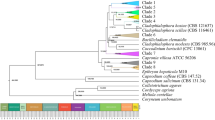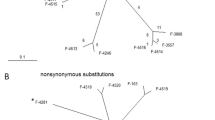Abstract
Phylogenies based on ITS and LSU sequences show that the Sparassis crispa complex comprises several monophyletic clades, in some cases co\rresponding to named taxa (i.e. S. crispa, S. radicata), but others lacking names (i.e. eastern and southwestern North American S. “crispa”). In our study, morphological examination of numerous collections also distinguished subtle differences correlated with geographic distribution. Underlying these problems, several taxa lacked type specimens for taxonomic analysis. In this paper, appropriate epitypes are designated and names assigned. Extensive sexual compatibility experiments, described within, indicate that monokaryon, haploid isolates of collections from North America and Europe are consistently sexually compatible to some degree. Inherent in the study, different “species concepts” were tested, with the “biological species concept,” based on sexual compatibility, being the least restrictive. We propose two new taxa, S. americana and S. americana f. arizonica.











Similar content being viewed by others
References
Ainsworth AM, Parfitt D, Rogers HJ, Boddy L (2010) Cryptic taxa within European species of Hydnellum and Phellodon revealed by combined molecular and morphological analysis. Fung Ecol 3:65–80
Bickford D, Lohman DJ, Sodhi NS, Ng PKI, Meier R, Winker K, Ingram KK, Das I (2007) Cryptic species as a window on diversity and conservation. Trends Ecol Evol 22:148–155
Binder M, Hibbett DS, Larsson K-H, Larsson E, Langer E, Langer G (2005) The phylogenetic distribution of resupinate forms across the major clades of mushroom-forming fungi (Homobasidiomycetes). Syst Biodiv 3:1–45
Breitenbach J, Kränzlin F (1986) Fungi of Switzerland Vol 2: Nongilled Fungi
Bruen TC, Philippe H, Bryant D (2006) A simple and robust test for detecting the presence of recombination. Genetics 172:2665–2681
Bruns TD, Gardes M (1993) Molecular tools for the identification of ectomycorrhizal fungi−taxon-specific oligonucleotide probes for suilloid fungi. Mol Ecol 2:233–242
Bryant D, Moulton V (2003) Neighbor-net, an agglomerative method for the construction of phylogenetic networks. Mol Biol Evol 21:255–265
Burdsall HH, Miller OK (1988a) Type studies and nomenclatural considerations in the genus Sparassis. Mycotaxon 31:199–206
Burdsall HH, Miller OK (1988b) Neotypification of Sparassis crispa. Mycotaxon 31:591–593
Cai L, Giraud T, Zhang N, Begerow D, Cai G, Shivas RG (2011) The evolution of species concepts and species recognition criteria in plant pathogenic fungi. Fungal Divers 50:121–134
Cannon PF, Kirk PM (2007) Fungal families of the world. Centre for Agricultural Bioscience International, Amsterdam
Carlsen T, Engh IB, Decock C, Rajchenberg M, Kauserud H (2011) Multiple cryptid species with divergent substrate affinities in the Serpula himantioides species complex. Fung Biol 115:54–61
Cotton AD (1907) On the structure and systematic position of Sparassis. Trans Brit Mycol Soc 3:333–339
Courtecuisse R, Duhem B (2008) Guide des champignons de France et d’Europe. Delachaux et Niestle. 476 pp
Dai Y-C, Wang Z, Binder M, Hibbett DS (2006) Phylogeny and a new species of Sparassis (Polyporales, Basidiomycota): evidence from mitochondrial atp6, nuclear rDNA and rpb2 genes. Mycologia 98:584–592
Delatour C (1975) Comportement in vitro du Sparassis crispa Wulf. ex Fr. et su Sparassis laminosa Fr. Eur J For Path 5:240–247
Desjardin DE, Wang Z, Binder M, Hibbett DS (2004) Sparassis cystidiosa sp. nov. from Thailand is described using morphological and molecular data. Mycologia 96:1010–1014
Felsenstein J (1985) Confidence limits on phylogenies: an approach using the bootstrap. Evolution 39:783–791
Fries EM (1819) Novit. flora svecica 5(cont.): 80
Fries EM (1821) Systema mycologicum. Lundae 1:1–520
Gilbertson RL, Bigelow DM (1998) Annotated checklist of wood-rotting basidiomycetes of the Sky Islands in southeastern Arizona. J Arizona-Nevada Acad Sci 31:13–36
Gilbertson RL, Martin KJ, Lindsey JP (1974) Annotated checklist and host index for Arizona wood-rotting fungi. Arizona Exp Stat Tech Bull 209:1–48
Gordon SA, Petersen RH (1997) Infraspecific variation among geographically separated collections of Marasmius androsaceus. Mycol Res 101:365–371
Gordon SA, Petersen RH (1998) Infraspecific variation among geographically separate collections of Marasmius scorodonius. Mycotaxon 69:453–466
Harder CB, Laessøe T, Kjøller R, Frøslev TG (2010) A comparison between ITS phylogenetic relationships and morphological species recognition within Mycena sect. Calodontes in northern Europe. Mycol Prog 9:395–405
Hawksworth DL (2006) Pandora’s mycological box: molecular sequences vs. morphology in understanding fungal relationships and biodiversity. Rev Iberian Micol 23:127–133
Hawksworth DL (2012) Addressing the conundrum of unavailable name-bearing types. IMA Fungus 3:155–157
Heitman J, Sun S, James TY (2013) Evolution of fungal sexual reproduction. Mycologia 105:1–27
Hibbett DS, Donoghue MJ (2001) Analysis of character correlations among wood decay mechanisms, mating systems, and substrate ranges in homobasidiomycetes. Syst Biol 49:215–242
Hibbett DS, Ohman A, Glotzer D, Nuhn M, Kirk P, Nilsson RH (2011) Progress in molecular and morphological taxa discovery in fungi and options for formal classification of environmental sequences. Fungal Biol Rev 23:38–47
Huelsenbeck J, Ronquist F (2000) MrBayes: Bayesian inferences of phylogeny (software). University of California, San Diego
Hughes KW, Petersen RH, Lickey EB (2009) Using heterozygosity to estimate a percentage DNA sequences similarity for environmental species delimitation across basidiomycete fungi. New Phytol 189:795–798
Hughes KW, Petersen RH, Lodge DJ, Bergemann S, Baumgartner K, Tulloss RT, Lickey EB, Cifuentes-Blanco J (2013) Evolutionary consequences of putative intra- and interspecific hybridization in agaric fungi. Mycologia. doi:10-3852/13-041
Huson DH, Bryant D (2006) Application of phylogenetic networks in evolutionary studies. Mol Biol Evol 23:254–267
Jülich W (1981) Higher Taxa of Basidiomycetes. Vaduz, J. Kramer
Kornerup A, Wanscher JH (1967) Methuen handbook of colour. Methuen & Co., London
Kreisel H (1983) Zur taxonomie von Sparassis laminosa Fr. s.l. Fed Report 94:675–682
Light W, Woehrel M (2009) Classification of the nomenclatural confusion of the genus Sparassis [Polyporales: Sparassidaceae] in North America. Fungi 2:10–15
Martin KJ, Gilbertson RL (1976) Cultural and other morphological studies of Sparassis radicata and related species. Mycologia 68:622–639
Mata JL, Hughes KW, Petersen RH (2007) An investigation of/omphalotaceae (Fungi: Euagarics) with emphasis on the genus Gymnopus. Sydowia 58:191–289
Moncalvo JM, Vilgalys R, Redhead SA, Johnson JE, James TY, Aime CA, Hofstetter V, Verduin SJW, Larsson E, Baroni TJ, Thorn RG, Jacobsson S, Heinz Clémençon H, Miller OK (2002) One hundred and seventeen clades of Euagarics. Mol Phylogen Evol 23:357–400
Nieuwenhuis BPS, Debets AJM, Aanen DK (2013) Fungal fidelity: nuclear divorce from a dikaryon by mating or monokaryon regeneration. Fung Biol 117:261–267
Nilsson RH, Kristinansson E, Ryberg M, Hallenberg N (2008) Intraspecific ITS variability in the kingdom Fungi as expressed in the international sequence databases and its implications for molecular species identification. Evol Bioinform 4:193–201
Osmundson TW, Cripps CI, Mueller GM (2005) Morphological and molecular systematics of Rocky Mountain alpine Laccaria. Mycologia 97:949–972
Petersen RH (1992) Mating systems in three New Zealand agarics. N Z J Botany 30:189–197
Petersen RH, Hughes KW (1999) Species and speciation in mushrooms. Bioscience 49:440–452
Posada D, Crandall KA (1998) Modeltest: testing the model of DNA substitution. Bioinformatics 14(9):817–818
Reid DA (1958) New or interesting records of British Hymenomycetes. II. Trans Brit Mycol Soc 41:419–445
Reid DA (1962) Notes on fungi which have been referred to the Thelephoraceae sensu lato. Persoonia 2:109–170
Reid DA (1965) A monograph of the stipitate stereoid fungi. Nova Hedwig Beih 18:1–382
Ridgway R (1912) Color standards and color nomenclature. Publ. Priv., Washington DC
Ryoo R, Sou H-D, Ka K-H, Park H (2013) Phylogenetic relationships of Korean Sparassis latifolia based on morphological and ITS rDNA characteristics. J Microbiol Biotech 51:43–48
Schaeffer JC (1763) Fungorum qui in Bavaria et Palatinu circa Ratisbonam nascuntur. Vol. II
Schaeffer JC (1774) Fungorum qui in Bavaria et Palatinu circa Ratisbonam nascuntur. Vol IV. Index primus. Synonyma et auctores
Sheedy EM, Van de Wouw APV, Howlett BJ, May T (2013) Multigene sequence data reveal morphologically cryptic phylogenetic species within the genus Laccaria in southern Australia. Mycologia 105:547–563
Swofford D (2002) PAUP* 4.0b10: phylogenetic analysis using parsimony (*and Other Methods). Sunderland, MA, Sinauer Associates
Taylor JW, Jacobson DJ, Kroken S, Kasuga T, Geisser DM, Hibbett DS, Fisher MC (2000) Phylogenetic species recognition and species concepts in fungi. Fung Genet Biol 31:21–32
Van de Putte K, Nuytinck J, Das K, Verbeken A (2012) Exposing hidden diversity by concordant genealogies and morphology - a study of the Lactifluus volemus (Russulales) species complex in Sikkim Himalaya (India). Fung Divers 55:171–194
Vilgalys R (1986) Phenetic and cladistic relationships in Collybia sect. Levipedes (Fungi: Basidiomycetes). Taxon 35:225–233
Vilgalys R (1991) Speciation and species concepts in the Collybia dryophila complex. Mycologia 83:758–773
Vilgalys R, Miller OK (1983) Biological species in the Collybia dryophila group in North America. Mycologia 75:707–723
Vilgalys R, Miller OK (1987a) Morphological studies on the Collybia dryophila group in Europe. Trans Brit Mycol Soc 88:461–472
Vilgalys R, Miller OK (1987b) Mating relationships within the Collybia dryophila group in Europe. Trans Brit Mycol Soc 89:295–300
Vincenot L, Nara K, Sthultz C, Labbé J, Dubois M-P, Tederson L, Martin F, Selosse M-A (2011) Extensive gene flow over Europe and possible speciation over Eurasia in the ectomycorrhizal basidiomycete Laccaria amethystina complex. Mol Ecol 21:281–299
Wang Z, Binder M, Dai Y-C, Hibbett DS (2004) Phylogenetic relationships of Sparassis inferred from nuclear and mitochondrial ribosomal DNA and RNA polymerase sequences. Mycologia 96:1015–1029
Weir JR (1917) Sparassis radicata, an undescribed fungus on the roots of conifers. Phytopath 7:166–177
White TJ, Arnheim N, Erlich HA (1989) The polymerase chain reaction. Trends Genet 5:185–189
Wulfen FX (1781) Plantae rariores Carinthiacae. In: Jacquin, 2. Misc. Austriaca Bot Chem Hist Nat 2:25–138
Yang ZL (2011) Molecular techniques revolutionize knowledge of basidiomycete evolution. Fungal Biodiv 50:47–58
Zhao Q, Feng B, Yang Z-L, Dai Y-C, Wang Z, Tolgor B (2013) New species and distinctive geographical divergences of the genus Sparassis (Basidiomyota): evidence from morphological and molecular data. Mycol Prog 12:445–454
Acknowledgments
Dr. Steve Trudell (University of Washington) and Mr. Brian Luther organized and furnished specimens and spore prints of S. radicata; Dr. Nadezhda Psurtseva furnished dikaryon cultures from the Komarov Botanical Institute, St. Petersburg, Russia. Ms. Rita Rentmeester expedited dikaryon cultures from CFMR, which represented several collections cited by Martin and Gilbertson (1976), and Dr. Beatriz Ortiz-Santana arranged a loan of specimens from CFMR. Dr. Egon Horak investigated the herbarium of IB and identified specimens of S. crispa from the topotype area. Research was supported by a US National Science Foundation Grant to RHP and KWH.
Author information
Authors and Affiliations
Corresponding author
Electronic supplementary material
Below is the link to the electronic supplementary material.
ESM 1
Crosses between single-spore isolates of Sparassis radicata exemplars. Collections used are: TENN49093 (BC); TENN56253 (CA); TENN67982 (WA); TENN67985 (WA); TENN67997-SAT 295-01 (WA); TENN67999- SAT 301-01 (OR). Solid line = four successful crosses from four attempts with different single-basidiospore isolates. Long dash = three successful crosses of four attempts. Medium dash = two successful crosses of four attempts. Short dash = one successful cross of four attempts (JPEG 49 kb).
ESM 2
Crosses between single-spore isolates of exemplars of the Sparassis crispa complex. Collections used are: TENN65974 (TN), TENN65584 (NC; E-US S. “crispa” hybrid between clades I and II), TENN65971 (TN E-US S. “crispa” hybrid between clades I and II), OKM 7058 (MD, dikaryon culture from CFMR; E-US S. “crispa” clade II); KJM 279 (AZ; spontaneously fruiting dikaryon culture from CFMR); TENN67997-SAT 295-01 (WA; S. “radicata”), TENN67999-SAT 301-01 (OR; S. “radicata”), LE 043 (Germany, S. crispa, dikaryon culture from the Komarov Botanical Institute, St. Petersburg, Russia). Solid line = four successful crosses from four attempts with different single-basidiospore isolates. Long dash = three successful crosses of four attempts. Short dash = two successful crosses of four attempts (JPEG 73 kb).
Rights and permissions
About this article
Cite this article
Hughes, K.W., Segovia, A.R. & Petersen, R.H. Transatlantic disjunction in fleshy fungi. I. The Sparassis crispa complex. Mycol Progress 13, 407–427 (2014). https://doi.org/10.1007/s11557-013-0927-1
Received:
Revised:
Accepted:
Published:
Issue Date:
DOI: https://doi.org/10.1007/s11557-013-0927-1




